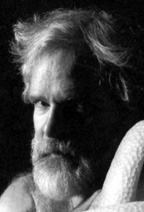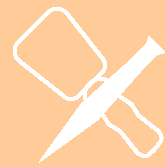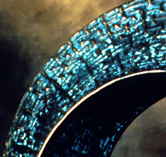|
Helaman Ferguson
–
mathematical sculptor
|

|
"
What worthless looking rocks await my hand and mind to transform them to beautiful and irresistible artifacts with the imprint of timeless mathematical theorems? "
|

|
| |
|
|
|
| |
How were you motivated to choose your particular field? |
| |
I suppose I generate evidence of life in the face of death.
My natural father was a visual artist, my natural mother
a model in an art school in Los Angeles. I was born
in Salt Lake City, probably closer to Mars than LA in many
respects, especially the high arid mountain plateau. My
mother was killed by lightning when I was three, my father
drafted into the Pacific theater of World War II. Life
on Earth has its risks. My adopted father was an Irish
stone mason, my adopted mother from colonies in northern
Mexico, and they graciously raised me in upstate New York.
My genetic nature was art and science, my environmental
nurture was learning to work with my hands and to appreciate
raw materials of little apparent value. As a kid I was
pretty raw myself. As I went through the New York Regents
public school system in the post–Sputnik era I had many
opportunities to study science. I chose to do creative
math in a liberal arts college rather than an engineering
school. Our society tends to compartmentalize people and
professions, maybe with good reasons. Overcoming this
compartmentalization has been a continuing battle for me.
I refuse to be diminished by being just a mathematician,
by being just a sculptor––I persist in both. Fortunately
for me our society on Earth is diverse enough to permit both.
While it is likely the colony could make room for some of
my work, what would be the effect on a creative artist of
the colony's intense socialization and immediate survival goals?
Would a Martian colony built upon valid constraints in the
face of omnipresent life and death risks have room for me?
|
|

|
| |
|
|
|
| |
What can you share about your creative process? |
| |

|
|
At this moment I see two parts, mental and physical. It is
important to me that they are hard to separate. Mental:
mathematics, its ideas, symbols, and equations are an
essential part of my personal design language. Much of my
sculptural body of work celebrates the remarkable achievements
of mathematics as an abstract art form––a human activity
spanning thousands of years. These ideas combined with my
tools and materials take the form of an undeniable will.
Physical: my aesthetic choice of raw materials tends to be
stone from geological activity spanning millions of years.
It is very exciting for me to learn a new stone. I have one
now, one billion years old, waiting for me to stop writing here.
I use many different kinds of specialized tools, including
computers, virtual image projection from equations, tool
position and orientation monitoring, air hammers and drills,
carbide cutters, diamond corers and saws, diamond chains,
cables, pulleys, hydraulic rams, gantry cranes. This is a
high risk environment of air, electricity, water, dust, and
chips which calls for special breathing apparatus, vision
and hearing protection, various kinds of body armor and
insulation. Definitely postmodern man. I use hammer and
chisel too, but while a lot has changed, it is the same as
when our ancestors banged a soft rock with a hard rock and
made a magical form.
My mathematical forms arrive by my
subtractive process: my computer tool position and orientation
monitoring system does not do the cutting work, I do. The
system gives me quantitative information. I want it this way
because I learn the mathematical form which no one has ever seen,
touched, felt, walked around, or crawled through. This learning
is like learning a piece of music or dance by heart. Having
learned the new form, it becomes part of my sculptural repertoire,
independently now of the computer system. My studio is a door
or canal through which mathematically designed things take
form with Earth's geological materials. For the mental part,
the same mathematics and design language is true on Mars; for
the physical part, what would be the result of my working
with martian materials?
|
|
| |
|
|
|
| |
What ideas do you have for a future human community on Mars?
|
| |
At this point I have more questions than ideas. Mars as a new
environment offers new risks––does lightning kill mothers on Mars?
If not there will be other perhaps more interesting risks, certainly
ones not easily predicted from here. Risks cause communities to
respond, and I suppose that it is important to accept in advance their appearance.
What about the risk of the colony harboring an artist or generations
of them? My family heritage is of pioneers and colonizers. Indeed,
I have found it important to leave the colonies of my origins and
take up residence in older more deeply rooted communities, which
can support my work in emotional as well as material ways.
Even so, carving stone, even with computers as I do, involves operating
in a
harsh environment. In the process of carving stone I undo, by violence,
millions of years of geological material forming processes. With each
new stone I carve I learn how to undo its geology and at the same
time to convolve it with mathematical ideas. What raw materials does
the red planet offer me as a sculptor? What worthless looking rocks
await my hand and mind to transform them to beautiful and irresistible
artifacts with the imprint of timeless mathematical theorems?
See more of Helaman Ferguson's mathematical sculpture at:
http://www.access.digex.net/~helamanf/index.html
See information about the book, Helaman Ferguson; Mathematics in Stone and Bronze at:
http://www.msstate.edu/Fineart_Online/Gallery/Ferguson/maths.html
|
|

|
|




